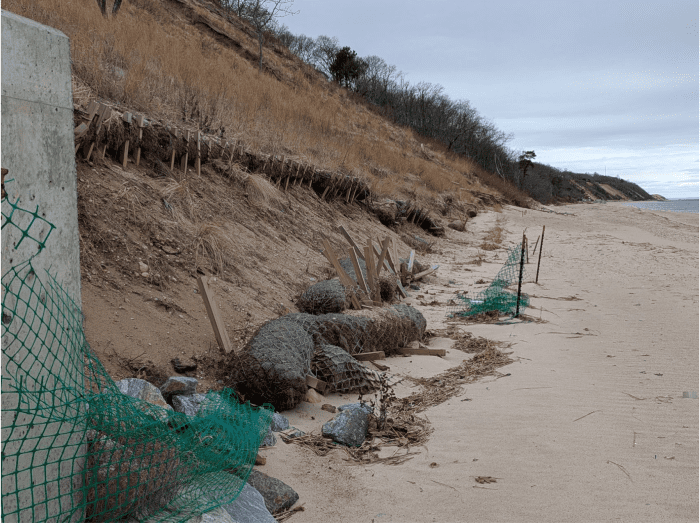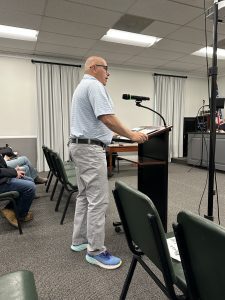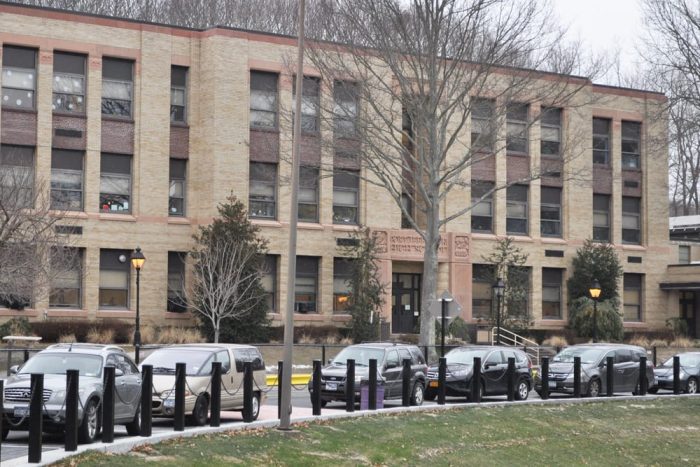By Lynn Hallarman
A community informational forum about Phase 2 of the East Beach Bluff stabilization project was held by village officials at the Port Jefferson Village Center on March 27.

The forum aimed to update residents on the current status and finances of the upper wall project, summarize the next steps and review the work of Port Jefferson’s Citizens Commission on Erosion.
Mayor Lauren Sheprow presided over the meeting. The board of trustees, village attorney David Moran, village treasurer Stephen Gaffga and clerk Sylvia Pirillo were present.
Project summary
Phases 1 and 2 of the East Beach Bluff stabilization aim to halt bluff erosion and prevent the Village of Port Jefferson-owned country club from collapsing down the slope.
Phase 1 was completed in August of 2023, with the construction of a 358-foot wall of steel and cement at the base of a steep bluff, about 100-feet-tall, facing north toward the Long Island Sound. Terracing and plantings installed along the western portion of the bluff were destroyed in a series of storms shortly after the project’s completion.
Phase 2 involves installing a steel barrier driven into the bluff’s crest, just a few feet seaward of the country club. This upper wall is intended to stabilize the area landward of the bluff and reduce the risk of structural failure.
As part of Phase 2’s preconstruction, GEI Consultants of Huntington Station—the engineers for Phases 1 and 2—will be engaged to update the land survey, analyze drainage options, reevaluate wall design for cost efficiency and monitor construction. Village officials will then prepare requests for proposal documents to solicit bids for the upper wall’s construction.
Concerns of the Citizens Commission on Erosion

David Knauf, chair of the Citizens Commission on Erosion, presented the benefits and concerns of various approaches to stabilizing the country club at the bluff’s edge.
The CCE serves as a volunteer advisory group to the village on erosion-related issues. Members are not required to have specialized expertise.
Among the advantages, Knauf noted that a portion of Phase 2 costs will be covered by a Federal Emergency Management Agency grant, reducing the financial burden on local taxpayers. However, the committee expressed concerns about the reliability of FEMA funding.
“If they are withdrawn, that is going to put us in a heap of trouble fiscally,” he said.
Key concerns include the unknown long-term costs of the overall project beyond the Phase 2 wall installation. These include a drainage plan, repairs to damage sustained during Phase 1 and ongoing maintenance expenses.
“All of us on the committee are taxpayers, and we’re concerned about getting value for money spent,” Knauf said. “The bluff wall project is not something that you just do and you’re finished. It’s going to have responsibilities and obligations for the village in perpetuity.”
Knauf outlined alternative approaches to building the upper wall, including:
●Rebuilding the clubhouse inland in conjunction with bluff restoration and drainage improvements.
●Implementing a partial wall and drainage plan, followed by the eventual relocation of the clubhouse.
“It is the opinion of the committee that detailed plans for the whole project — including Phase 1 repairs, drainage and Phase 2 — are completed so an accurate assessment of final costs can be presented to the village taxpayers,” Knauf later told TBR News Media in an email.
Comments from GEI
Following Knauf’s presentation, GEI licensed professional engineer Adon Austin explained the steps necessary before construction can begin on the upper wall.
The project is designed as a “two-part system [lower and upper wall] working in combination to control bluff erosion,” Austin said.
“Once we have the design reconfigured and a drainage plan, all of this will go to the New York State arm of the Federal Emergency Management Agency for review,” he added. “FEMA will then revise the cost estimates, the scope and the grant, to align with what the current scope of the project would be.” GEI will then issue a final design along with construction documents.
GEI has recommended that the village evaluate the current risk to the building’s foundation in response to written questions from the Citizens Commission on Erosion.
Laura Schwanof, senior ecologist and landscape architect for GEI, commented on possible contributing factors to the current erosion of the bluff face:
“ We were only allowed [by the state Department of Environmental Conservation] to put terraces up six rows — nothing more.” Schwanof said. “ We were prevented from doing any structural work on the western end beyond the golf course. As far as failure of the system, we worked within the confines of the regulatory agency requirements.”
Treasurer outlines project costs
Village treasurer Stephen Gaffga presented an overview of the financial history related to the East Beach Bluff stabilization project. To date, the total amount spent so far for Phases 1 and 2 is approximately $6.02 million.
Phase 1 was funded through borrowed money as part of a $10 million bond resolution passed by the board of trustees in 2021. The resolution was approved by a permissive referendum, meaning it did not move to a public vote. Of the $10 million, “$5.2 million was spent on Phase 1,” Gaffga said.
According to a fall 2024 audit by CPA firm, PKF O’Connor Davies — previously reported by TBR News Media — Phase 1 exceeded its original budget by approximately $800,000. This overage was not discussed during the forum.
“The overage on Phase 1 was paid for in past years with taxpayer funds out of the general fund balance,” Gaffga wrote in an email..
Gaffga estimated the combined costs to individual taxpayers for Phases 1 and 2 at approximately $77 per year over a 15-year period. However, he noted this estimate may need to be revised once actual costs for the wall construction and other related projects are known.
”We don’t know what the costs are going be until we actually go out to bid on the construction of the project, and we’re not there yet,” Gaffga said.
Additional expenses — including a drainage project, repairs to the bluff face and ongoing maintenance costs to the bluff — were not addressed at the forum.
Community questions focus on costs, property use
Most audience questions centered on the project’s cost to taxpayers, technical aspects of the stabilization effort and how the property is used by residents. The golf membership currently includes “3 percent of village residents,” according to Moran.
Moran responded to a question about holding a public referendum on whether to proceed with construction of the upper wall or rebuild the facility inland.
“During that permissive referendum vote back in 2021, no petition was received [from the public within 30 days] as required for a public vote. Bond counsel to the village advised that there’s only one way to call for another vote— the trustees would have to rescind that initial bond resolution. This would mean the loss of FEMA money.”
Village resident Myrna Gordon said in a statement to TBR News Media:
“Residents who own the facility should be the ones that determine through a referendum how best to resolve its use, function and future — of both the building and bluff that is so greatly compromised.”
The meeting closed with comments from members of the board of trustees:
“Phase 2 is a way to ensure that we protect the bluff so that we buy time. To decide how to deal with the building. Maybe we retrieve the building; maybe it gets moved — who knows?” trustee Xena Ugrinsky said.
“ If you have strong feelings about this issue, I highly encourage you to email the board,” trustee Kyle Hill said.
The Citizens Commission on Erosion can be reached at: [email protected].



















